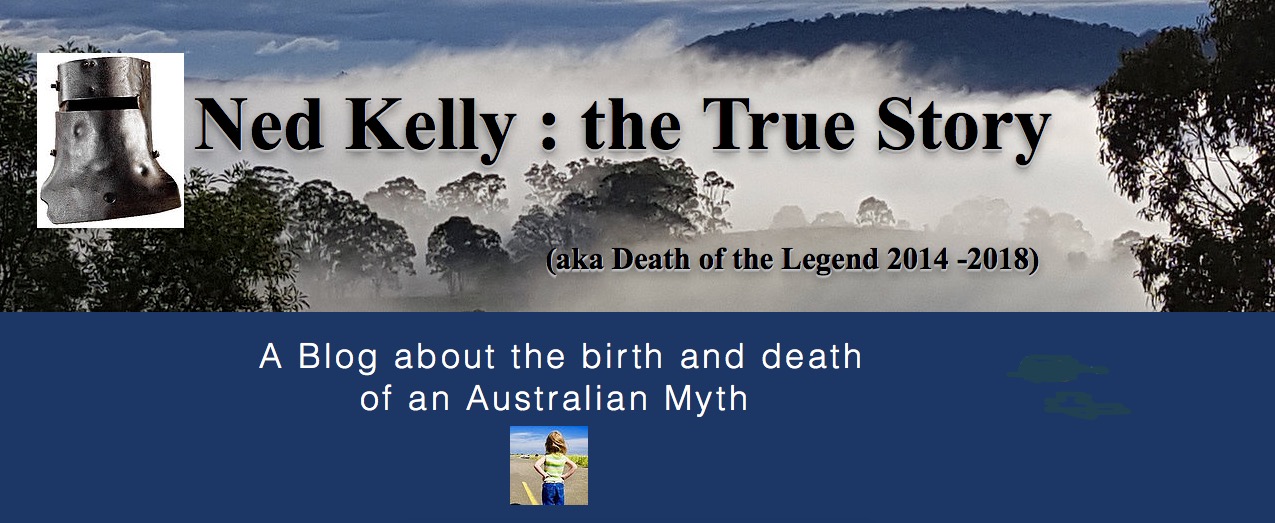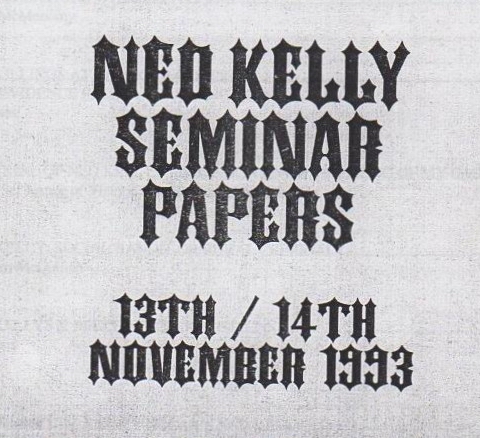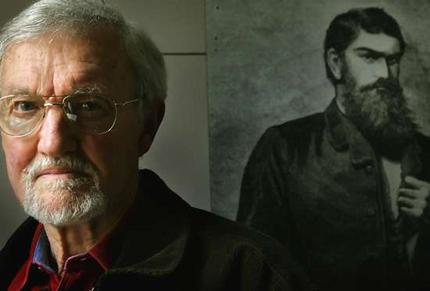Ian Jones landmark Lecture, A New View of Ned Kelly, followed Louis Wallers lecture about Ned Kellys trial,
which Jones described as ‘brilliant’,
saying ‘perhaps it is appropriate that we
should follow an examination of a legal judgement on Ned Kelly with what
amounts to a moral one. Ned Kelly was found guilty, legally.
Was
he guilty morally?”
To answer his question, Jones
then proposes in this lecture ‘to look at
some important aspects of the man which
perhaps we have not glimpsed yet’ ; to look at the conditions which led up to
Ned Kelly’s personal revolt against injustice; to look at the conditions in the
north eastern district and in Victoria as a whole, which created a situation in
which rebellion could develop’ and ‘at the way in which Kelly’s personal
rebellion became associated with a broader rebellion of the selector class in
the North east’
Jones decribes his lecture as “an attempt – a first attempt, I believe –
to bring some meaning to this mass of material, to reconcile documentary
evidence with these frustrating fragments of verbal tradition which have come
down to us”
So, to start with he focussed
on the person of Ned Kelly, who he said in 1967 was still largely “a faceless inhuman figure. He is almost
anonymous behind the plough-steel helmet”. So, figuratively taking off the
armour, this is what Jones finds inside, in his own words :
*Physically Ned Kelly was almost superhuman. This sounds an extravagant statement
in every way but the man WAS physically remarkable
*He was an outstanding boxer…. Ned Kelly’s boxing prowess was
symptomatic of strength and endurance which he displayed to a spectacular
degree in his Last Stand”
*Ned
Kelly was a crack horseman.
*Ned
Kelly was acknowledged to be one of the finest trick riders that the people of
his time had seen
*
He was also a crack shot
*He
emerges as a surprisingly quiet and gentle man…a restraining figure…a man curbing
the hotheads among the sympathisers
*a
man who, when it was aroused, had tremendous anger
*He
possessed a degree of vanity but not without some reason. He was proud of his
boxing ability, he was proud of his personal appearance
*He
trusted people…Fitzpatrick to an almost ludicrous degree and of course he
trusted Curnow
*utterly
devoted to his family
*over
many of Ned Kelly’s actions we see this paternalism
*Ned
Kelly was Irish…. Two hundred years of bitterness and hatred lay behind him. He
was the son of an Irish convict
Moving on from his description
of the Ned Kelly Ian Jones saw inside the armour, he spoke about the ‘the
conditions which led up to Ned Kelly’s personal revolt against injustice’. Here
he discussed the local persecution of the Kelly family by Police, saying of
Kenneallys version that ‘perhaps it went
too far’ but ‘the fact remains that
the Kelly family were persecuted’ He quotes the famous directive of Superintendent
Nicholson, ‘to bring them to justice and
send them to Pentridge. Even on a
paltry sentence’. Added to this, was
the ‘bitter land war being waged by
Whitty and other squatters of the district, and the small selectors’. On a
much wider scale, there was ‘an economic
depression and political ferment’ which led to the ‘notorious Black Wednesday of January 8th 1878’ which saw
the wholesale sacking of civil servants including county court justices and
police magistrates. This was a desperate
means to eke out the dwindling finances
of Government as expenditure drained the last supply vote…..Police expenditure
was hacked back. Men who left the force were not replaced and many country
stations were broken up” This was ‘a
demoralised community, a period of bad debts and bankruptcy in all levels of society. People in almost
every town could see bank managers and officers being charged with embezzling
funds or shire secretaries absconding with public money. There were Bank
failures, mass meetings of unemployed’
“Victoria
was ready for rebellion” he said.
Constable Fitzpatricks
response to all this uncertainty, according to Jones was to attempt to enhance his credentials in
the eyes of his superiors, and thereby his prospects of keeping his job, by
biting off more than he could chew in attempting to take on the notorious Kellys.
Instead, ‘those mysterious events of
April 15th at the Kelly homestead’ resulted in Mrs Kelly going
to jail for three years, and then three weeks later three police died at the
hands of Mrs Kelly’s son at ‘the
Stringybark Creek gunfight’. According to Jones, Stringybark Creek was ‘not the act of a gang of bushrangers making
their first blow against the police. In point of fact Stringybark Creek was an
act of personal rebellion by Ned Kelly. A personal blow against police who had
come out after him and his brother…’
Jones says there was no
immediate support for the Kellys, other than from relatives and close friends. There
was fear and suspicion of the Kellys until after ‘they conducted two brilliantly planned and executed bank robberies, probably
the two most immaculate exploits in the history of Australian bushranging’.
Now, according to Jones , and especially after the holdup at Jerilderie ‘with its magnificent flair and its many
wonderful touches’ suddenly people had a new view of these ‘gentleman
bushrangers’. Additionally, the arrests and subsequent release without charges
having been laid of a few dozen Kelly sympathisers between January and April 1879 ‘had swung a huge body of people throughout
the North east toward support of the gang’…..The injustice of this stupid
manoeuvre was aggravated by the fact that the period of imprisonment straddled
the harvest time”
Nevertheless Jones records
that ‘One way or another the sympathisers
harvests were brought in. It was another bad season and about a quarter of the
harvest was destroyed by rust anyway”
The final straw for the poor
selectors of the North East, according to Jones was the decision to deny land
selections to known Kelly sympathisers. ‘This,
I believe was the turning point in the support of the Kelly gang’. Now, Ned
Kelly’s previously identified ‘paternalism’ resulted in him feeling responsible
for what was happening to his fellow Irish selectors, and so he warned in the
Jerilderie letter, that if they did not
receive ‘justice and liberty I will be
compelled to show some colonial stratagem that will open the eyes not only of the Victoria police but also the
whole British Army….Fitzpatrick will be the cause of greater slaughter to the
Union Jack than St Patrick was to the snakes and toads of Ireland.’
At this point Jones introduces
the central revelation of his ‘New View’ saying “I have heard the story from many different people, told usually as a
deep and dark piece of information – once or twice referred to as the United
States of Australia. Whether this was Ned Kelly’s concept, Joe Byrnes concept;
whether it had filtered through from the ideas of American republicanism given
to Ned Kelly by his stepfather George King; whether it sprang from some
politically minded person among the sympathisers trying to realise in this
growing rebellion in the north-east, the great promise of Ned Kelly the
figurehead…..we will never know…..But the fact is indisputable that by the
beginning of 1880 the rebellion was taking shape”
According to Jones, Ned Kelly
then went about raising a ‘selector army’
and making suits of armour from mould boards stolen from nearby farms. Kelly’s
plan involved using the murder of former gang associate Aaron Sherritt as bait
to lure a special trainload of Police into the district from Melbourne. The
train would crash at high speed where the Gang had ripped up the tracks near
Glenrowan, the gang in their armour would then act as ‘shock troops’, and ‘mop up’
any survivors from the train wreck, and then in response to the firing of two
rockets ‘the sympathisers would ride at
the gallop, clutching the guns which had been given them by the gang to follow
them in raids on the banks at Benalla, Wangaratta, possibly Beechworth. And
then what? The Republic of Victoria? Holding the Governor to ransom? We don’t
know”
Jones declared “This was a ruthless and brutal act, but it
wasn’t a criminal act. This was an act of war”
Jones then quickly sums up
what actually happened at Glenrowan and provides an account, based on eye
witness reports which he said are ‘confused
and contradictory’ of an ‘extraordinary
meeting’ between the seriously wounded Kelly and the Sympathiser army on the
shoulder of Mt Glenrowan. “By some miracle, he had mounted the grey
mare Music and met the sympathisers on horseback.” Kelly turned the army
back, because the plan had ‘miscarried’
saying to them “This is our fight’ and “I am prepared to die” He then returned
to the Inn in ‘his last magnificent
possibly futile attempt to rescue the these two young men (Dan and Steve)
‘Ned
Kelly had been losing blood for more than five hours in near zero temperatures.
He was carrying ninety-seven pounds of armour”. Jones says of
this episode: “This seems unbelievable
but it is true”
Neds capture, trial and
execution are mentioned briefly but Jones devoted the remainder of the lecture
to a discussion about the fate of the ‘rebellion’ Oral traditions were that an
uprising was still being contemplated but by the end of 1881 ‘the Kelly outbreak was at last over’
Jones concludes by saying that
the Kellys were ‘much more than mere
criminals’ and we would be justified in saying that “Ned Kelly the man was infinitely greater than his legend, a man of
greater nobility and moral courage than anything we have even hinted at in the
past” In other words, Jones answer to his own question, “was he guilty morally?” is an emphatic
‘No”.
DEES COMMENTS
Much of what Jones delivered in
that speech at Wangaratta 50 years ago is familiar to all of us today, but back
then, I think it must have been electrifying to hear him draw so many disparate
and contradictory elements of the Kelly story into a coherent and magnificent narrative
that seemed to make sense of everything. As anyone who has ever heard or seen Jones
speak knows very well, he is now and clearly was then a brilliant and
accomplished speaker and story teller, and I imagine the audience would have
been listening in rapt and amazed silence to his every word. His quiet delivery
radiates a beguiling kind of genial professorial modesty and believability that
speaks of integrity and a desire for truth.
Jones “New View” became the
dominant narrative for much of the next half century, its most radical component
being the idea that Ned Kelly was some sort of figurehead for an incipient rebellion
in north-east Victoria. In this view, the Glenrowan affair was more to do with
a wider political inspiration that merged with Ned Kelly’s personal rebellion.
Later, Jones made his view clear that without such a justification Ned Kelly’s
plan was ‘madness’.
The other components of the new
view were support for Ned Kelly’s declaration that his family was persecuted
and treated unfairly by corrupt Police and that he was largely a ‘police made’
criminal, and acceptance of Jones belief that the north-east was in turmoil because of Police behaviour toward
Irish-Australian selectors, and the policies of a Government in crisis.
What I found remarkable,
reviewing this lecture in detail was how extreme were Jones view of the Kellys. By
the time he came to publish his great biography of Ned, “A Short Life’ in 1995 he had toned down much of the rhetoric,
but even then it was obvious he regarded the Kellys as ‘much more than mere criminals’ . To Ian Jones Ned Kelly was an
almost mythical human being and admirable hero , “a man of greater nobility and moral
courage than anything we have even hinted at in the past”. Kelly, according to Jones was ‘almost superhuman’ a crack shot, a fine
rider, an outstanding horseman, a quiet and gentle man, a restraining figure, paternalistic
vain and proud but ‘utterly devoted’ to
his family. Theres virtually no suggestion anywhere in this 'new view' of any fault in the man, whose acts
we might have thought were criminal but were acts of war, whose robberies were ‘brilliantly planned’… ‘immaculate’
exploits with ‘magnificent flair’ and ‘many wonderful touches’, and whose
behaviour at Glenrowan was ‘magnificent’ a miracle and ‘unbelievable but true’. He barely
wastes a sentence on the three murdered Police, Aaron Sherritt or the horror of mass murder
planned for Glenrowan where what the Gang was about to do was, in Ian Jones chilling
words “mop up the survivors”. He thus
set the tone for the next 50 years in which the police murders, the terrors of
being taken hostage by a killer with a gun waving in front of your face, the
coldblooded murder of Aaron Sherritt and the planned mass killing at Glenrowan
are dismissed as what we now refer to as ‘collateral damage’. In his rush to
canonise Ned Kelly, in this lecture Jones fails to notice the horrors and the brutality of Kellys deeds, or even of his violent threatening
and outrageous boasts in the Jerilderie letter.
In addition to his hyperbolic
views about the Kellys and Ned in particular, in this lecture Jones also
creates a hyperbolic view of social conditions at the time. He uncritically
accepts the view that the Kellys were persecuted, - a view we now realise is completely
at odds with the facts - and paints a
picture of a social environment almost at boiling point with the Government at
war with itself, people being thrown out of work and widespread ‘economic
depression and political ferment’. “Victoria was ready for rebellion’ he
declared.
This view was immediately challenged from the floor of the conference
room by Weston Bate, a professional historian who denied there was widespread
chaos and unrest, who said there was certainly NOT a depression in the region,
and who claimed ‘in many ways this was
the best time for selectors in Victoria. The majority of them were on their feet..”
he said. ‘Black Friday’ was NOT the great catastrophe painted by Ian Jones – of
a population at the time of around 750,000, less than 400 were sacked. Subsequent
research by Doug Morrissey for his PhD thesis confirmed Bate was right, but
neither then nor since has Ian Jones backed down “We are in happy disagreement ‘ he concluded at the time.
Despite Jones brave hope, evidence
of the republic of north-east Victoria in the form of a fabled ‘declaration’ has not emerged, the
person who claimed to have seen it has changed his story and the informants
upon whom Jones relied have confessed they gave mischievous information to him and
contradictory accounts to other researchers. The idea that the Kellys were
persecuted by the Police, the idea that the north-east was in turmoil and the selectors
were about to rebel or else go under, the idea that Glenrowan was devised as
some sort of political act rather than a mad criminal one – all these pillars
of Jones imaginative Kelly narrative have all been eroded and collapsed under
the weight of the scholarship that followed. You can read my post that shows that Jones Republic Mythology has absolutely nothing to support it HERE.
The “New View’ is not only no longer 'new' it is now a
completely discredited theory that had its roots in the lies Ned Kelly told about his background, was made attractive by some of the physical attributes of the man and the inherent glamour of the bushranger on horseback, and came alive in the romantic tale woven by the spellbinding Mr Jones. He took us all for a quite wonderful
romantic and exciting ride back into history, but it turns out the colourful
hero, near superman, moral crusader and ‘physically remarkable’ Ned Kelly was a
fantasy. The real Ned Kelly we now know was someone altogether different, albeit still fascinating in his own criminal way but someone very much less attractive than Jones Legend.
I suppose we all should say ‘Thanks
Ian, it was great while it lasted.’


